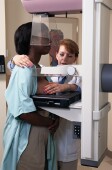
TUESDAY, July 6 (HealthDay News) — While more Americans are being screened for colon and breast cancer than ever before, millions aren’t getting the tests and thousands are dying needlessly as a result, according to U.S. health officials.
Two new reports from the U.S. Centers for Disease Control and Prevention find that rates of recommended screening for colon cancer have risen from 52 percent of adults in 2002 to 63 percent in 2008. And, by 2008, just over 81 percent of women aged 50 to 74 were getting mammograms as recommended, about the same level as in 2006.
However, the CDC said that 7 million women who should have had a mammogram recently have gone without the potentially lifesaving screen, and 22 million Americans who should have undergone colon cancer screening have not done so.
“Most deaths from colon cancer could be prevented by screening technologies that are available today,” CDC Director Dr. Thomas R. Frieden said during a press briefing to announce the new findings.
“We are encouraged by increases in colon cancer screening rates over the years,” he added.
According to Frieden, some of the increase in the screening rates for colon cancer is due to the attention brought to the disease by CBS News anchor Katie Couric, whose 2004 on-air colonoscopy highlighted the disease and the test. Couric lost her husband Jay Monahan to colon cancer in 1998.
“Nevertheless, there is a lot more progress we could make with colon cancer screening,” Frieden said. “There are more than 20 million Americans between the ages of 50 and 75 who need to be screened, who have not been screened. If they were [screened] that would save thousands of deaths per year.”
In terms of breast cancer, there has been a leveling off of breast cancer screening rates in recent years, Frieden said.
“We know that mammography does prevent breast cancer and prevent the spread of breast cancer and saves lives, so we want to see that continue to increase,” he said.
Speaking at the press briefing, Dr. Marcus Plescia, director of CDC’s Division of Cancer Prevention and Control, noted that there are several barriers that prevent some people from being screened for these cancers.
“There are a number of disparities,” he said. “Disparities based on race and ethnicity, disparities based on lack of insurance, and disparities based across geographic regions.”
Colorectal cancer is the second leading cause of cancer death in the United States, after lung cancer, and breast cancer is the most commonly found cancer and the second leading cause of cancer deaths among U.S. women, according to the CDC.
Other highlights from the reports include:
For colorectal cancer screening:
- People with health insurance are more likely to be screened than the uninsured (66 percent to 36 percent, respectively).
- Colorectal screening varied by state from 74 percent in Massachusetts to 53 percent in Oklahoma.
- The highest rates of colorectal cancer screening were in the Northeast (74 percent in Maine, Delaware, and Massachusetts).
- The lowest rates were in the Ccntral and western regions, (Oklahoma 53 percent, Arkansas 53 percent and Idaho 54 percent).
- Screening rates were low among all racial and ethnic minorities except for blacks.
- Other factors associated with low screening rates include low income (48 percent) and having less than a high school education (46 percent).
For breast cancer screening:
- The lowest rates of breast cancer screening were among American Indian and Alaska Native women (70 percent).
- Screening rates were lower among women with less than a high school education (73 percent), and low income women (69 percent).
- Mammography rates were lowest in the western and southern states of Nevada (72 percent), Mississippi (72 percent), and Idaho (73 percent).
- More insured women were screened than uninsured women (84 percent versus 56 percent).
- However, even 16 percent of insured women did not have an up-to-date mammogram.
Screening is an important life-saving tool, the CDC said. In 2006, more than 139,000 new cases of colorectal cancer were diagnosed and more than 53,000 people died from this cancer.
Screening tests can find precancerous polyps so they can be removed before they turn into cancer. Screening can also detect colorectal cancer at an early stage, when treatment is most effective, according to the CDC.
In 2006, more than 191,000 women were diagnosed with invasive breast cancer and more than 40,000 died from the disease. Mammograms are the best way to find breast cancer early, when it is easiest to treat.
The new reports find that a doctor’s recommendation for screening is an important — yet underused — motivator. Encouraging doctors to prioritize cancer screening would greatly boost testing rates, the CDC said.
More information
For more on colon and breast cancer, visit the American Cancer Society.

